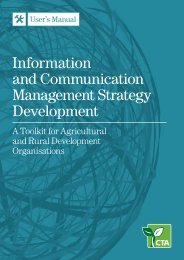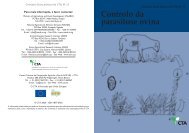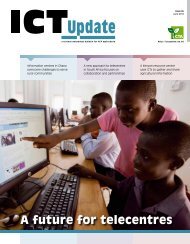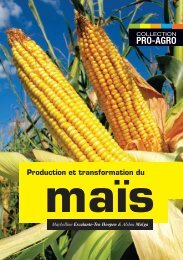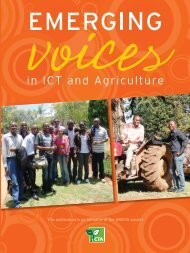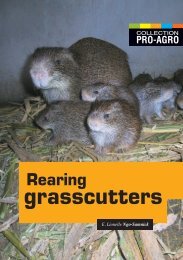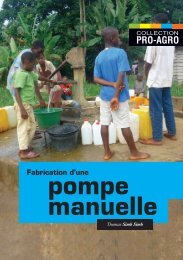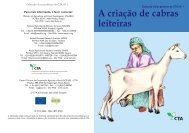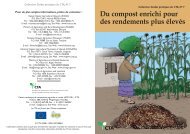Policy framework for Pastoralism in Africa
Policy framework for Pastoralism in Africa
Policy framework for Pastoralism in Africa
- No tags were found...
You also want an ePaper? Increase the reach of your titles
YUMPU automatically turns print PDFs into web optimized ePapers that Google loves.
water po<strong>in</strong>ts and pastures. Conflict resolution is envisaged via a conciliation commission made upof herders, farmers, local government representatives and other concerned parties.In the CEMAC region of Central <strong>Africa</strong>, specific cooperation <strong>in</strong>struments are also emerg<strong>in</strong>g suchas the cooperation agreement creat<strong>in</strong>g CEBEVIRAH (Economic Commission <strong>for</strong> Livestock, Meatand Fish) across CEMAC countries. This will promote the development of the livestock andfisheries sector, and is of particular relevance to pastoralists.In COMESA, a draft <strong>Policy</strong> Framework <strong>for</strong> Food Security <strong>in</strong> Pastoralist Areas was released <strong>in</strong> late2009, under the Comprehensive <strong>Africa</strong> Agriculture Development Porgramme (CAADP) Pillar 3.This <strong>framework</strong> proposes regional harmonization of national policies to support regional movementsof pastoralists to enable efficient use of transnational rangeland ecosystems, and <strong>for</strong> livestocktrade. These approaches fall with<strong>in</strong> the overall COMESA mandate of economic <strong>in</strong>tegration andthe free movement of people, goods and services with<strong>in</strong> the COMESA region. The COMESA policyalso provides a <strong>framework</strong> <strong>for</strong> balanced <strong>in</strong>vestments <strong>in</strong> domestic, regional and export livestocktrade from pastoral areas.In IGAD, a Regional <strong>Policy</strong> Framework on Animal Health was f<strong>in</strong>alized <strong>in</strong> late 2009 which althoughnot directly focussed on pastoralism, was very relevant to the large pastoralist areas of IGADMember States.Regionalisation also carries risks, especially if new policies are not well implemented. The freecross-border movements of goods and persons can contribute to <strong>in</strong>security, and the spread of animaland human diseases (especially HIV/AIDS), if proper and adequate control measures are not put<strong>in</strong> place and efficiently implemented.3.3 Contemporary pastoral policy and development challengesDespite considerable progress towards supportive policies, pastoralists cont<strong>in</strong>ue to suffer fromcultural and spatial isolation, and political marg<strong>in</strong>alization <strong>in</strong> many <strong>Africa</strong>n countries. Humandevelopment and food security <strong>in</strong>dicators rema<strong>in</strong> low, and the provision of public services <strong>in</strong> pastoralzones is still weak, and generally far lower than <strong>in</strong> other areas of a given country. Basic<strong>in</strong>frastructure also falls beh<strong>in</strong>d other areas, and <strong>in</strong> common with service delivery, is relatively costlyto provide and ma<strong>in</strong>ta<strong>in</strong> <strong>in</strong> large and remote pastoral areas. Conflict cont<strong>in</strong>ues to have a majorimpact on human welfare and limits economic development.3.3.1 ConflictIn specific regions and countries, various types of conflict cont<strong>in</strong>ue to have direct impacts on pastoraliststhrough physical violence and damage to <strong>in</strong>frastructure, and <strong>in</strong>direct impacts such aslimited private sector <strong>in</strong>vestment due to <strong>in</strong>security. Indeed, many analysts regard conflict as themajor constra<strong>in</strong>t to development <strong>in</strong> pastoralist areas. Across East, West and Central <strong>Africa</strong> arenumerous examples of protracted conflicts and the impacts. Notably, the ma<strong>in</strong> victims of armedconflicts are not the combatants but civilians, and among civilians, women and children suffermost. Abuses such as child kidnapp<strong>in</strong>g, use of child soldiers, rape and <strong>for</strong>ced marriages are widelyreported. As pastoralists flee from conflicts, they can f<strong>in</strong>d themselves <strong>in</strong> long-term camps <strong>for</strong> the<strong>in</strong>ternally displaced, or move <strong>in</strong>to areas where they face new tensions as they compete <strong>for</strong> resources24 <strong>Policy</strong> <strong>framework</strong> <strong>for</strong> <strong>Pastoralism</strong> <strong>in</strong> <strong>Africa</strong>




